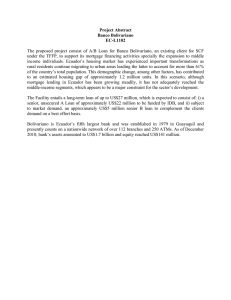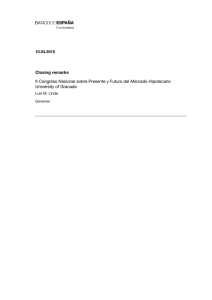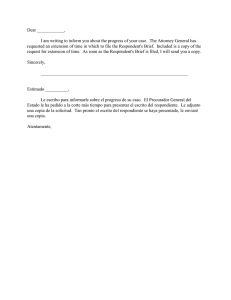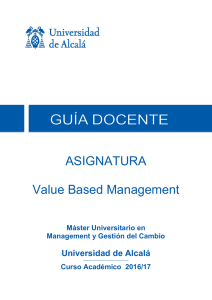the institutions of housing financing in argentina - Inter
Anuncio
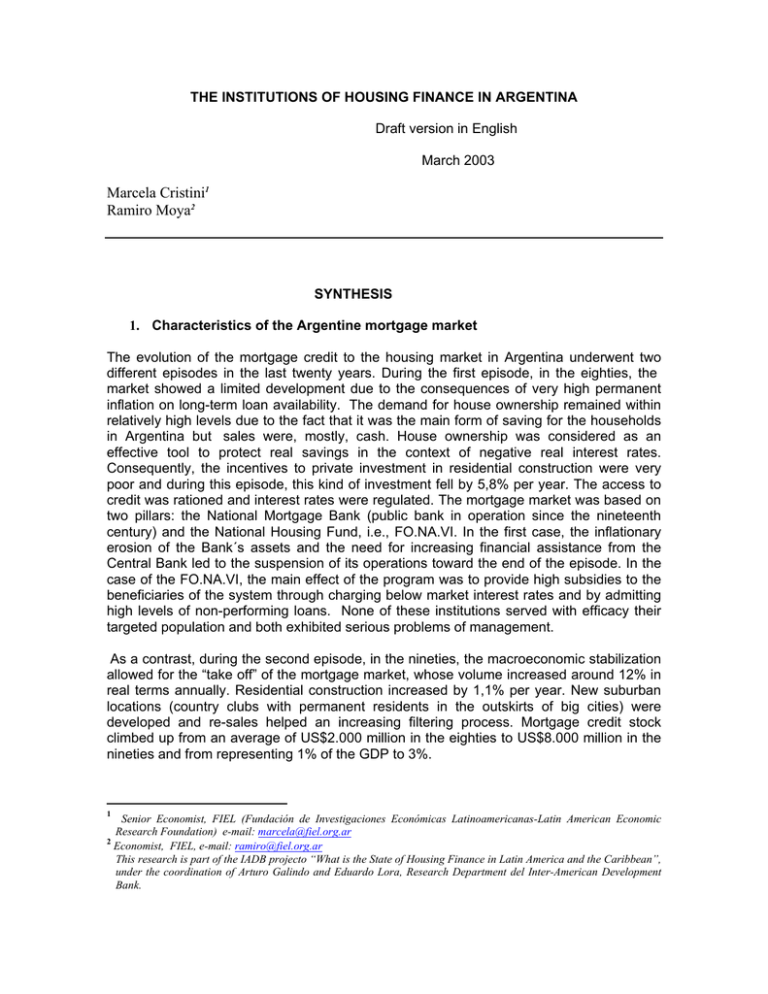
THE INSTITUTIONS OF HOUSING FINANCE IN ARGENTINA Draft version in English March 2003 Marcela Cristini1 Ramiro Moya2 SYNTHESIS 1. Characteristics of the Argentine mortgage market The evolution of the mortgage credit to the housing market in Argentina underwent two different episodes in the last twenty years. During the first episode, in the eighties, the market showed a limited development due to the consequences of very high permanent inflation on long-term loan availability. The demand for house ownership remained within relatively high levels due to the fact that it was the main form of saving for the households in Argentina but sales were, mostly, cash. House ownership was considered as an effective tool to protect real savings in the context of negative real interest rates. Consequently, the incentives to private investment in residential construction were very poor and during this episode, this kind of investment fell by 5,8% per year. The access to credit was rationed and interest rates were regulated. The mortgage market was based on two pillars: the National Mortgage Bank (public bank in operation since the nineteenth century) and the National Housing Fund, i.e., FO.NA.VI. In the first case, the inflationary erosion of the Bank´s assets and the need for increasing financial assistance from the Central Bank led to the suspension of its operations toward the end of the episode. In the case of the FO.NA.VI, the main effect of the program was to provide high subsidies to the beneficiaries of the system through charging below market interest rates and by admitting high levels of non-performing loans. None of these institutions served with efficacy their targeted population and both exhibited serious problems of management. As a contrast, during the second episode, in the nineties, the macroeconomic stabilization allowed for the “take off” of the mortgage market, whose volume increased around 12% in real terms annually. Residential construction increased by 1,1% per year. New suburban locations (country clubs with permanent residents in the outskirts of big cities) were developed and re-sales helped an increasing filtering process. Mortgage credit stock climbed up from an average of US$2.000 million in the eighties to US$8.000 million in the nineties and from representing 1% of the GDP to 3%. 1 Senior Economist, FIEL (Fundación de Investigaciones Económicas Latinoamericanas-Latin American Economic Research Foundation) e-mail: [email protected] 2 Economist, FIEL, e-mail: [email protected] This research is part of the IADB projecto “What is the State of Housing Finance in Latin America and the Caribbean”, under the coordination of Arturo Galindo and Eduardo Lora, Research Department del Inter-American Development Bank. Figure 1 Argentina: Housing Mortgage Loans (Stock in US$ millions ) PRÉSTAMOS HIPOTECARIOS PARA LA VIVIENDA* 12.000 4,5 4,0 10.000 8.000 3,0 Millones de $ 2,5 % del PBI 6.000 2,0 4.000 % del PBI En millones de $ de 2001 3,5 1,5 1,0 2.000 0,5 00 99 98 97 96 95 94 93 92 01 20 20 19 19 19 19 19 19 19 19 90 89 88 87 86 85 84 80 79 78 91 19 19 19 19 19 19 19 19 19 19 76 77 19 19 19 75 0,0 19 19 74 0 * Diciembre de cada año The interest rates went down to pair an 11% in dollars, contracts were mostly denominated in dollars, LTVs grew steadily to range between the 70 and 80% of property market value and the mortgage contracts extended their length from two/five years to ten/fifteen years. Household access to mortgage loans broadened considerably since mid-nineties supplied by private commercial banks and a bunch of public banks. TABLE 1 Argentina: Characteristics of Total Mortgage Lending Note: 1. Mortgage loans (total) in US$ millions; 2. Structure by loan length in years; 3. Share of dollar denominated loans; 4. Percentage of fix interest rate loans in total loans; 5. Percentage of variable interest rate loans. Características de los flujos de créditos hipotecarios totales 1993* 1) Monto de Préstamos hipotecarios (1) 2) Distribución de Plazos Hasta 5 años Entre 5 y 10 años Más de 10 años 3) Participación de créditos en US$ 4) Emisión de créditos a tasa fija 5) Emisión de créditos a tasa variable 1994 1995 1996 1997 1998 1999 2000 2,189.3 4,426.8 2,985.5 3,929.9 4,846.6 4,751.6 3,418.6 4,412.8 2,753.6 74.7% 55.2% 62.3% 54.0% 46.6% 46.7% 34.3% 41.9% 26.5% 13.4% 32.0% 21.0% 20.0% 21.9% 22.3% 28.8% 21.0% 25.4% 12.0% 12.8% 16.7% 26.1% 31.5% 30.9% 36.9% 37.1% 48.1% 79.0% 85.7% 84.1% 91.0% 88.5% 90.2% 88.5% 95.3% 96.4% 44.8% 45.2% 46.6% 49.6% 49.5% 35.6% 22.8% 38.2% 36.4% 55.2% 54.8% 53.4% 50.4% 50.5% 64.4% 77.2% 61.8% 63.6% Fuente: Elaboración propia en base al BCRA (1) En millones de Pesos/Dólares (Ley de Convertibilidad), incluye comerciales y para la vivienda. * Período junio-diciembre. 2. Economic policy and legal framework The development of the mortgage market was immersed in a new scenario characterized by economic and financial reform. A banking system composed of private and public banks provided “universal” commercial services to the economy and was at the center of the financial sector. Along with an important concentration in banking structure in the nineties3, banks also changed their business strategies. They specialized with respect to client types. Several banks focused on lending to prime companies whereas other banks tied their “customer relationship” with traditional medium companies. An ulterior feature related to bank strategies was the development of specialized departments on pledges by product (such as automobiles, manufacturing machinery, agricultural machinery) and on housing mortgages Several institutions also showed their interest in the development of warrants. Enhanced prudential and supervision regulations were implemented as a key ingredient of the economic reform and contributed to an early recovery of trust in the financial system after the Tequila crisis. Along with international standards in banking supervision (Basle standards) the Central Bank introduced novel “market-oriented” regulations to complement 3 2001 Argentina had 400 banks operating in the 80s, 136 during the 90s and 76 in 2001. overseeing responsibilities of the banking system through investors, auditors and rating agencies. The resulting regulatory framework combined financial market liberalization with strict regulatory requirements. These requirements slightly favored the increase of mortgage lending share in bank´s portfolio. During the decade deposits and loans grew at a good pace, the domestic interest rate showed a converging path to the international standard due to country risk reduction and the banking system shifted lending from the government as a major client to the private sector, particularly big firms and households. In 2000 banking loans (stock) represented 22% of GDP as compared to capital market financial instruments (commercial papers), around 8%. Since 1993 the housing mortgage market reappeared after a long period when economic instability acted as a deterrent to its operation. The new macroeconomic environment favored the development of the housing market. Building industry resumed growth providing new housing to high and middle income households, the private banking system increased the mortgage credit supply using their own funding or distributing National Mortgage Bank funds (second floor banking institution at the time). As regards the interest rates and despite the diminishing path that it exhibited after the Tequila crisis, the average lending rate in Argentina remained high by international standards. Spreads in dollars and in pesos calculated as the difference between lending and deposits interest rates also remained high. It may also be noted that interest rates show an important variation across banks that cannot be explained by the heterogeneity of financial product mix and that this variation dominates the variation along time. The following Table suggests that the very high interest rates in Argentina be essentially due to personal loans and to overdraft facilities. According to available analysis on these financial instruments, the structure of the corresponding interest rates reflects risk implicit in these lending contracts. Loans secured on collateral (pledges), mortgages and loans advanced on documents (bill discounted) were all below the average. Mortgage lending and pledges attracted lower rates due to the presence of the real guarantee and in spite of the shortcomings of the judicial system in the country. TABLE 2 INTEREST RATES (annual %) Note: Titles in columns correspond to: 1. Prime rate(30 days);2. Overdrafts; 3. Discounting Bills; 4. Mortgages; 5. Pledges; 6. Personal loans; 7. Average Lending Rate; 8. Deposit rate; 9. Country risk (basic points) Tasas de interés en moneda extranjera (% anual) 1993 1994 1995 1996 1997 1998 1999 2000 Prime 30 Adelantos Tasa Tasa Riesgo días en Cta. Documentos activa Pasiva país sola firma Hipotecarios Prendarios Personales promedio Cte. (pbs) (Argentina) 8,1 19,7 13,4 16,2 17,2 20,6 15,1 5,8 318 9,8 21,2 14,8 15,5 17,4 20,4 16,0 6,1 787 10,8 17,7 14,7 15,7 17,3 24,2 16,4 7,4 1113 8,8 14,0 11,2 13,0 15,1 22,2 13,5 6,0 500 8,6 14,4 11,0 11,9 14,7 21,3 12,9 6,5 418 9,3 11,2 11,9 12,6 13,4 21,8 13,2 6,7 706 10,3 10,7 13,4 13,3 15,1 23,1 14,5 7,1 665 9,4 8,9 11,9 12,6 15,4 24,0 13,5 6,9 794 Tasas de interés en moneda nacional 1993 1994 1995 1996 1997 1998 1999 2000 1/ (% anual) Prime 30 Adelantos Tasa Riesgo Documentos Tasa Hipotecarios Prendarios Personales activa días en Cta. país 1/ sola firma Pasiva Cte. promedio (Argentina) (pbs) 10,4 36,8 20,6 16,6 22,4 38,6 33,5 8,7 318 13,6 36,6 21,2 16,0 25,1 37,9 33,3 9,6 787 12,2 37,9 16,1 13,4 23,4 42,1 33,9 9,2 1113 10,5 30,5 13,5 12,5 21,5 40,1 28,3 7,6 500 12,6 29,6 14,2 14,2 17,5 34,4 27,1 8,3 418 10,8 30,6 13,6 15,7 22,2 25,0 27,8 8,1 706 13,4 31,0 13,3 14,7 20,3 32,3 26,7 10,3 665 10,0 29,2 11,6 15,4 21,6 33,1 25,3 7,9 794 Medido por el Embi. Fuente: Elaboración propia en base a datos BCRA. To understand the relevance of the mortgage market in Argentina it is useful to know the structure of the housing market . In 1995, approximately 70% of Argentine households owned their own houses. Half of these properties were built or bought new by their current owners, the other half corresponded to house re-sales. Only 12 % of households held debts originated in housing investment (buying or renovation). There was no record of the source of their funding, though the estimates suggest that most of it corresponded to bank loans. Only 12 % of households rented their house and this share has been stable for at least a decade . In 2001, the mortgage market amounted to 4,5% of total loan contracts in the banking system equivalent to 505.000 contracts with an average loan of US$31.774. The average contract was below this latter figure for loans granted by private banks (US$ 28.300) and above for loans granted by public banks (US$39.412). Average non-performing loan ratio was 17% of total loans and mortgage loans were slightly below that ratio, exhibiting a 16% non-performing loan ratio. In synthesis, during the nineties the Argentine financial system evolved towards the recovery and “take off” of the mortgage credit to finance house ownership. Which are the reasons behind this evolution? Several hypotheses are identified by our analysis: 1. Macroeconomic stability and market oriented policies in the financial system were the main determinants of the increase in deposits and decrease of nominal interest rates. The availability of increasing lending funds determined the increase of all kinds of loans including mortgages. 2. Price stability and economic predictability allowed to extend loans over longer periods. In the case of mortgage, loans were granted over a ten to fifteen years period. 3. The possibility to denominate mortgage contracts in dollar terms help the extension of repayment period and improved the value of the collateral over time. 4. The increasing share of foreign private banks in the domestic financial system, pushed competition and help decrease the interest rate. 5. The legal framework put in place to launch for securitization potentially enabled the development of a secondary mortgage market. 6. The organization of a public credit bureau and the existence of private supply on debtor´s information provided banks with convenient tools to select proper households to allocate new loans. The microeconomic analysis of bank behavior in the mortgage market also shows very interesting features during the period: ¾ Impressive increase of deposits in the banking system as compared with Argentine past financial evolution changed the dynamics of lending decisions; ¾ Privatization of public banks including the National Mortgage Bank reduced distortions in mortgage allocation and levelled the playing field for all banks participating of the mortgage market. ¾ Foreign private banks, particularly the Spanish ones, were interested in developing the mortgage market counting on their home country experience and know-how. They used the mortgage loan to attract new clients and as a distinctive product of their financial service package to customers. ¾ Mortgage loan contracts were modernized by enacting a new law to protect creditors rights that included an extrajudicial process of loan recovery. During this period the ten top banks of the system concentrated 75-80% of total mortgage loans. TABLE 3 Indicators of Banking Concentration in the Mortgage Market December 2001 Note: Column 1, Total amount in thousand dollars; Column 2, Share of top ten banks in the Mortgage market; Column 3, Share of top five banks; Herfindahl Index Indicadores de concentración en el mercado de créditos hipotecarios totales Diciembre de 2001 Monto (en miles US$) 1995 1996 1997 1998 1999 2000 2001 9,992,518 10,965,898 12,562,350 15,457,233 6,028,939 7,051,839 16,059,782 Participación Participación de los 10 de los 5 Indice de primeros primeros Herfindahl bancos bancos 77.9% 66.8% 1,625 78.3% 67.3% 1,598 79.4% 64.2% 1,313 82.5% 65.3% 1,172 79.5% 62.9% 1,090 74.8% 59.2% 963 79.4% 62.8% 1,087 Fuente: Elaboración propia en base a datos BCRA. One of the consequences of increasing competition among a bunch of large banks was the availability of improved information by potential clients through advertising and direct contact with well-trained credit officers. This helped to reduce the level and dispersion of interest rates among financing institutions and over time. Administrative costs charged on mortgage also diminished noticeably. TABLE 4 Administrative charges charged by banks on mortgage loans Gastos bancarios del crédito hipotecario * Máximo Mínimo 1998 4,9% 1,11% 2001 2,27% 1,81% Fuente: Elaboración propia sobre datos Secretaría de Competencia. * Sobretasa calculada como puntos adicionales a la tasa de interés en operaciones hipotecarias a tasa fija en créditos de US$ 40.000 a 10 años Considering our description of the mortgage market during the nineties we elaborated several hypotheses on the demand and supply behaviors and provided with an estimation of the reduced form of the market. We also estimated the structural equations corresponding to alternative specifications of the mortgage demand and supply not included here. TABLE 5 Variable dependiente: DLOG(HIPTOMOSA) Muestra (ajustada): 1993-08; 2001-12 (101 observaciones) Método: LS-White Heteroskedasticity-Consistent Standard Error and Covariance. VARIABLE ECUACION 1 ECUACION 2 COEFICIENTE COEFICIENTE (t-estadístico) (t-estadístico) C DLOG(WSA) LOG(Q/ICC) 1.428 2.305 0.620 1.832 -0.495 -1.930 DLOG(DES) BHIPOT ESP_HIPOT DLOG(CPRESTMA(-6)) LOG(EMBI) AR(1) R-cuadrado R-cuadrado ajustado Estadístico Durbin-Watson Estadístico F Prob(F) -0.285 * -1.579 -0.222 * -0.786 0.635 2.098 -0.025 -2.997 -0.024 * -0.158 0.432 0.389 1.978 10.094 0 0.960 1.701 0.597 1.758 -0.401 -1.750 -0.138 -1.633 -0.031 * -0.267 0.820 2.495 0.010 * 0.073 0.404 0.366 1.952 10.626 0 ECUACION 3 COEFICIENTE (t-estadístico) 1.533 2.323 0.583 1.696 -0.560 -1.958 -0.099 -1.031 -0.218 -1.028 -0.099 -0.280 0.623 2.099 -0.021 -2.481 -0.039 -0.266 * * * * 0.440 0.392 1.981 9.049 0 * No significativa al 10%. The definition of variables is the following: HIPOTMOSA : stock of mortgage credit for housing in dollars, seasonally adjusted. TASHIP: mortgage interest rate in nominal terms. WSA: monthly nominal wage, seasonally adjusted Q/ICC: price of dwelling by m2 / cost of construction DES: number of unemployment subsidies allocated by month. BHIPOT: share of the National Mortgage Bank in total mortgage lending. D94-96: dummy to control for the Tequila crisis CPRESTMA: lending funds in the banking sector, moving average. EMBI: country risk indicator DOPTIMO: dummy to control for peak in business cycle in 1997- 1998. ESP_HIPOT: share of Spanish banks on total mortgage lending. Our estimates show that the demand for mortgage loans responds with a low elasticity (negative) to the interest rate and is relatively elastic to income. The unemployment rate growth and mostly, the dwelling real price diminished the demand for housing finance during the period. The market widened as a consequence of the previous increase in banking lending capacity and it was modestly, but negatively, affected by macroeconomic risk. The level of economic activity and the competition with other financing applications within the banks´ portfolio did not affect the mortgage credit. From the bank´s viewpoint the mortgage loan shows a low financial risk and a high diversification capacity which compensated its lower yield. In fact, the mortgage was the only financing instrument that did not undergo the “crowding out effect” from the public sector that was increasing its indebtedness with the banking sector heavily during the final period of the decade. To illustrate these aspects we considered the changes in the portfolio structure of the banking system during the period in the following Table. TABLE 6 Argentina: Portfolio structure indicators of the banking system Note: 1. Structure in Jan-1994; 2. Structure in Jan-00; 3.Average yield during the period; 4. Variability Coefficient of yield; 5. Beta coefficient:; 6. Correlation coefficient between the share of each alternative financial instrument and the share of mortgage loans in the banking system portfolio Indicadores del portafolio de los bancos Composición Composición Inicial En-94 Final En-00 (1) (2) Adelantos 11% Overdraft Descuentos 27% Discount bills Hipotecarios 13% Mortgage Prendarios 6% Pledges Personales 9% Personal loans Otros 8% Other Valores Privados 2% Commercial papers Sector Público 24% Loans to the public sector Total Promedio 100% Total/ Average Fuente: Elaboración propia. Coeficiente de Rendimiento Variabilidad promedio del del período Rendimiento (3) (4) β (5) Correlación entre las participaciones en la cartera de cada instrumento con la hipoteca En-94/00 (6) 6% 31,3 82,2 1,6 0,35 22% 13,5 79,1 1,0 -0,73 16% 13,9 14,8 0,4 1 6% 16,6 29,0 0,6 s.d. 10% 32,6 29,7 0,7 0,47 7% 24,2 60,3 1,2 -0,42 4% 9,5 78,7 0,6 0,84 29% 14,2 76,5 0,9 0,71 100% 17,7 9,4 nc nc 3. The role of the judiciary and the legal costs of mortgage recovery During this episode the evolution of the mortgage market does not seem to have confronted any important institutional obstacle. However, the operation of the credit market (its volumes and costs) is influenced by legal regulations that define the credit contract and the rights and obligations of debtors and creditors. In Argentina these contractual relationships have a solid grounding in law. Thus, this section is devoted to analyzing legal and judicial procedures in order to assessing their influence on the mortgage market. Many of these contracts, such as pledge loans, mortgages, warrants, letters of credit, etc. have a long history in Argentine legislation (since the end of the 19th Century), although in some cases the laws governing them have been modified to ensure they are adapted to new market developments. Other instruments, such as trusts (included in the reform of the mortgage contract, Law 24,441) and the changes to the law on bankruptcy (Law 24,432) have arisen in the context of economic reforms with the aim of creating new markets (securitization) or flexibilizing the use of economic resources (introduction of cramdown in bankruptcies). In Argentine banks are able to bring so-called “administrative proceedings” for loan recovery in cases where loans have been granted against a pledge or a mortgage. Without bringing a court case to execute the pledge or foreclose the mortgage the bank can request the judge to authorize the seizing of the asset, which is auctioned off, the proceeds being notified to the judge. If the collateral does not cover the value of the amount due, the bank can initiate executive action (which is a court proceeding) to recover the balance, proceeding against the debtor and/or his guarantor. This possibility for “administrative execution” is not available to other kinds of creditors, who must of necessity resort to legal action to protect their rights. In Argentina bank loan contracts are defined and regulated by codes and national laws. In contrast, because of the federal nature of the country, enforcement of these regulations is in the hands of independent judicial powers in each province (24 in total and a federal jurisdiction for inter-provincial matters) set up according to the respective Provincial Constitutions. Naturally, the efficacy of contractual regulations depends not only on the norms they contain but also on their interpretation and application by the courts. Uneven approaches by local courts can lead to differences in access to credit and in their cost if the parties anticipate difficulties in the resolution of conflicts arising out of the loan contracts. Such difficulties can take the form of excessive costs of the legal process, slow or partial debt recovery or in a general increase in uncertainty regarding results. To illustrate on the disparity of costs between provinces we have collected data from a sample of judicial cases covering several provinces. Our conclusions are the following: ¾ There are not significant differences between the amount claimed and the one recovered through the judicial procedure. Administrative execution of loans is a recent legal procedure and it has not been tested enough in practice. TABLE 7 Recovered amount/ claimed amount in percentage Note: Province, Pledge execution, Housing Mortgage forclosure, Other Mortgage forclosure Proporción del monto dictado por la sentencia en relación al monto demandado Indicador Capital Federal Media Catamarca Media Chaco Media Corrientes Media Entre Ríos Media La Rioja Media Mendoza Media Misiones Media San Luis Media Santa Cruz Media Santa Fe Media T. del Fuego Media Nro. de Observaciones totales Ejecución Prendaria Ejec.Hipotec. de Ejec.Hipotec. de crédit.p/vivienda Otros créditos 93% 98% 97% 94% 97% 96% 100% 100% 99% 100% 100% 100% 100% 100% 100% 94% 93% 94% 100% 100% 100% 100% 100% 100% 100% n.d. 72% 99% n.d. 99% n.d. n.d. 99% 100% n.d. 100% 70 75 119 Fuente: FIEL (1999). ¾ Legal costs are very different among provinces. Court tax rates vary not only between jurisdictions but also with regard to the basis for calculation, using either the amount of the claim (with or without limits), the nominal principal or the restated principal. In the case of the seizure of pledges, there is no tax in some jurisdictions (7 out of 24) and in 3 cases it reaches a maximum of $ 90 when the court and filing taxes are added together. Contributions to the College of Lawyers vary according to jurisdiction. Some make no charge, others charge a fixed amount of between $ 4 and $17.50, and others charge percentage surcharges on the court tax or very significant direct percentages equivalent to an additional court rate of 2% on principal. ¾ In the case of registry costs, information available on property registers indicates that not only is the cost significant in some jurisdictions but there are sometimes delays in the processing of registrations that in extreme cases can run to several months. Vehicle registries are governed by federal law, so that costs are uniform in all jurisdictions. The cost of publishing edicts varies widely from jurisdiction to jurisdiction, as does the method use to set prices (by line, by character, etc.) and it is difficult to establish an average value per jurisdiction. Publications in the Official Gazettes of each jurisdiction can cost between $ 120 and $ 600. A similar range can be found in the case of publications of edicts in the newspapers with the largest circulation in each jurisdiction. ¾ Analyzing the costs of bringing a lawsuit (court taxes and College of Lawyerls fees, including the contributions to professional welfare funds) and expenses during the proceedings for selected locations in the case of pledge seizure and mortgage foreclosure, the results are the following: TABLE 8 Legal costs of credit judicial recovery Costos judiciales en la ejecución de créditos Caso: Ejecución hipotecaria (Mortgage foreclosure) Monto del litigio (Claimed amount): U$S 200.000. Jurisdicciones Seleccionadas Jurisdicción Cap. Fed. Pcia. Bs. As. Córdoba Mendoza Gastos inicio Edictos y Aportes Caja de Costos de Total de (tasa de just., Embargo Certificados Abogados tramitación y Costos Caja, etc.) de dominio s/honorarios gastos (aranceles) Judiciales 6,000 4,866 10,015 9,000 420 864 50 13 1,500 1,500 1,500 1,500 no 3000 (*) no no 300 300 300 (1)1300 8,220 10,530 11,865 11,813 Total del gasto como % del litigio 4.1% 5.3% 5.9% 5.9% (*) 10% de aportes calculado sobre honorario promedio (15% del monto del litigio) Nota: Se excluyen gastos de escrituración y honorarios profesionales (1) Corresponde al 0.5% por tasa de apelación o incidente que planteen las partes. Caso: Secuestro prendario (Pledge seizure) Monto del litigio: U$S 20.000. Jurisdicciones Seleccionadas Jurisdicción Cap. Fed. Pcia. Bs. As. Córdoba Mendoza Gastos inicio Edictos y Aportes Caja de Costos de Total de (tasa de just., Embargo Certificados Abogados tramitación y Costos Caja, etc.) de dominio s/honorarios gastos (aranceles) Judiciales 70 510(*) 1015(*) 73 No No No No 500 500 500 500 no 300 (**) no no 250 250 250 250 820 1,560 1,765 823 Total del gasto como % del litigio 4.1% 7.8% 8.8% 4.1% (*) Tasa de ley aplicada s/ el monto del litigio. No es criterio uniforme en toda la Pcia.,ya que en algunas jurisdicciones, se lo considera proceso con monto indeterminado, con un costo de $31 en Bs.As., y $102 en Córdoba. (**) 10% de aportes calculado sobre honorario promedio (10% del monto del litigio) Nota: No se incluyen gastos de transferencias y honorarios profesionales. Fuente: FIEL (1999). ¾ Auction costs are particularly high in Argentina, doubling the legal costs of the whole recovery process. TABLE 9 Judicial loan recovery costs including auction costs Costos judiciales en la ejecución de créditos, incluyendo los costos de subasta Caso: Ejecución hipotecaria (Mortgage foreclosure) Monto del litigio: U$S 200.000. Jurisdicciones Seleccionadas Gastos subasta (comisión Jurisdicción martillero, etc.)+21% IVA Cap. Fed. 7,260 Pcia. Bs. As. 7,260 Córdoba 14,520 Mendoza 7,260 Total de Costos Judiciales TOTAL 8,220 10,530 11,865 11,813 15,480 17,790 26,385 19,073 Nota: Se excluyen gastos de escrituración y honorarios profesionales. Total como % del litigio 7.7% 8.9% 13.2% 9.5% Caso: Secuestro prendario (Pledge seizure) Monto del litigio: U$S 20.000. Jurisdicción Cap. Fed. Pcia. Bs. As. Córdoba Mendoza Jurisdicciones Seleccionadas Gastos subasta Total de (comisión Total como % del TOTAL Costos martillero, litigio Judiciales etc.)+21% IVA 2,420 820 3,240 16.2% 2,420 1,050 3,470 17.3% 2,420 1,765 4,185 20.9% 2,420 823 3,243 16.2% Nota: No se incluyen gastos de transferencias y honorarios profesionales. Fuente: FIEL (1999). ¾ As regards the importance of professional fees, there are marked differences in the percentages applied in the various jurisdictions. In Córdoba for example awards are made of up to 30% of the amount claimed, whereas in San Luis there is a cap of 16% on the amount claimed. TABLE 10 Lawyer fees and judicial costs in loan recovery as % of claimed amount Pledge execution and Mortgage foreclosure Importancia relativa de los costos y honorarios relevados. Como % del monto demandado (capital + intereses) Jurisdicción Capital Federal Bs. As. Catamarca Chaco Córdoba Corrientes Entre Ríos La Rioja Mendoza Juicios Ejecutivos Otros costos Honorarios judiciales del trámite Intervalo Observado 8.7%-3.1% 21.8%-4.4% 28.7%-14.0% 41.9%-11.3% 7.7%-5.5% 31.9%-7.9% 22.2%-15.6% 24.1%-18.8% 25.0%-14.7% 30.9%-26.0% 22.0%-19.0% 26.3%-22.2% 15.1%-9.4% 18.3%-13.4% 12.0%-6.4% 12.9%-6.4% 20.4%-12.5% 24.6%-17.0% Ejecuciones Hipotecarias Otros costos Honorarios judiciales del trámite Promedios 7.9% 8.0% n.d. n.d. 18.9% 20.6% 20.2% 20.3% n.d. n.d. 13.5% 18.2% 9.6% 13.5% 7.1% 7.6% 7.6% 9.6% Nro. de Observaciones Totales 179 145 65 42 47 48 54 47 75 Fuente: FIEL. Nota: Juicios Ejecutivos comprende a los ejecutivos en general, ejecuciones por cuentas corrientes, por pagarés, P.V.E. y a las ejecuciones prendarias. ¾ Delays in recovery (in most cases lawsuits are excessively drawn out) often lead to banks accepting settlement proposals involving high discounts rather than taking a legal path entailing considerable risk of dispossession or disappearance of the debtor that the length of such processes encourages. In addition, in many cases, such as vehicle pledges, guarantees become obsolete. In several jurisdictions the courts determine the initiation of trial proceedings for enforcement actions in the face of any delaying action by the debtor, in spite of the fact that all procedural rules institute the right of either of the parties to subsequent trial proceedings. The provinces are more likely than the Federal Capital to take a case to trial. ¾ Lastly, in the following table there is a comparison between the provinces declared by the banks to have the “worst performance” and those considered to have the “best performance” with regard to time-frames and percentages of recovery of the amount claimed net of court costs and fees. TABLE 11 Delays and net recovery of loans Plazos promedio y porcentaje de recuperación del préstamo Comportamiento de las provincias (casos extremos) Juicios Ejecutivos Secuestros prendarios Ej. hip. para la vivienda Ej. hip. de otros créditos Otros A- PEOR COMPORTAMIENTO B- MEJOR COMPORTAMIENTO PLAZO EN MESES PLAZO EN MESES Inicio % de Inicio hasta % de recu- Inicio hasta Inicio hasta hasta recupero subasta pero neto sentencia subasta sentencia neto 10,8 21.8 20% 4,0 11.8 42% 2,3 8.6 55% 1,5 4.7 67% 9,5 18.4 67% 4,0 9.8 75% 12,5 24.0 56% 3,5 11.5 63% 36,0 48.0 10% 18,0 24.0 40% Fuente: FIEL (1999). The differences in legal costs and judicial efficacy in loan recovery have an impact on credit availability by region. In the case of mortgage loans this impact is suggested by the negative relation between the share of bank debts (personal and mortgage loans) of households and an indicator of judicial efficacy constructed using the previous data. FIGURE 3 Share of bank debts (personal and mortgage loans) of households related to indicator of judicial efficacy (the highest the index, the lower the efficacy) EFICACIA JUDICIAL Y ENDEUDAMIENTO DE LAS FAMILIAS 45 Deuda como % del ingreso familiar 40 35 30 25 20 15 10 5 0 0,0 0,2 0,4 0,6 0,8 1,0 Índice de Justicia (a mayor índice, menor eficacia) 4. The perspectives of the mortgage market in Argentina Due to the fact that toward the end of the nineties the housing mortgage finance presented an increasing trend it was unusual to find critics to its performance. In all, it was possible that the growth of the market was to face some obstacle in the future due to the scarce activity of banks in securitization and to the concentration of the suppliers to one sole kind of entity, banks. Some market operators point to a poor financing supply in the housing markets of smaller urban conglomerates where informal credit was organized through the notaries that covered both the financing of modest LTVs and the expenses of dwellings maintenance. Neither did appear intermediaries that allowed a major market coordination or favored the enlargement of banking business scale such as housing developers or mortgage originators for direct securitization in the capital market. In 2002, mortgage market development was abruptly interrupted by a severe macroeconomic crisis which ended in the default of the external debt and in a huge devaluation of the Argentine peso. The country abandoned the convertibility rule and adopted a floating exchange rate. This new scheme ended the second episode of mortgage market take off due to the breach of the mortgage contracts. This situation was a consequence of “pesification” through which dollar denominated contracts were converted into peso denominated contracts using a discretionary exchange rate (1,4 pesos = US$1 1,2 as compared to the market exchange rate of 2,5 pesos per dollar). This arrangement benefited indiscriminately the debtors producing an income transfer from creditors and risk investors. The suspension of executions, in time, eliminated momentarily the possibility of credit recovery. Under these conditions it is extremely difficult to assess up to what degree the crisis has affected the mortgage market which has been paralyzed since then. Considering the immediate future, re-structuring of the mortgage market will depend on the way in which the financial market will be re-organized. Firstly, if the monetary regulations allow for dollar denominated contracts, the mortgage credit could be denominated in hard currency and consequently, protected from inflation. Alternatively, if loans can solely be denominated in pesos it would be convenient the introduction of an accounting unit for denomination such as the Chilean UFs to protect the contract from inflationary erosion. Secondly, in the short run it will be very difficult to reduce the transaction costs derived from contract disruption and the interest rates to the levels prevailing in the nineties. Consequently the reconstruction of the market will be limited by the reduced length of the loans and by its higher costs under uncertainty. In this context any new regulation should explicitly take into account its potential transaction costs and the authorities should undertake a systematic effort to reduce them. Thirdly, under these conditions it would be convenient to create the incentives for other potential suppliers participating in the market (builders, loan and saving societies, cooperatives ). To do so several initiatives have to be put in place. Among them, information on debtors should be improved, the legal framework for a long term mortgage market connecting directly household demand with long term investors should be enacted and the Stock Exchange regulations should be reformed to include the specific needs of the mortgage credit. In these cases more flexible financial regulation should be explored in order to allow the participation of new institutions without wounding the market discipline and without increasing the systemic risk. Lastly, the normalization of judicial procedures of mortgage credit should urgently be undertaken. As regards social housing finance, the FO.NA.VI continues to be the most important program and its functioning is still deficient in spite of recent reforms that de-centralized it to the Provincial Housing Institutes and speeded up its management. It has been affected by poor management that resulted in recurrent leakage of subsidies towards high-middle income households, in high administrative costs and low credit recovery. In this case the reform proposed here organizes social expenditure in housing in two separate programs: 1. Provision of housing subsidies to replace slums and 2. Provision of housing subsidies and access to the credit market to targeted households according to the income level. Each program should work independently and both should include an active role of households to select the kind of contract they will have to comply with through a combined scheme of public subsidies and banking credits. 5. Concluding remarks During the nineties the mortgage market in Argentina experienced a “take off” that was abruptly interrupted by an exogenous macroeconomic crisis in 2002. Factors favoring this evolution were: the release of households liquidity constraint that followed the deep economic and financial reform in early nineties; the use of dollar denominated contracts, the reorganization of the financial system including foreign banks with long experience in mortgage contracts in their own countries that used mortgage to attract clients; the privatization of the National Mortgage Bank and the reform of the National Housing Fund that partially ceased unfair competition with private financing institutions in serving middle income households; the modernization of the legal institutions backing the mortgage contract including securitization procedures. Negative factors during the period were: the increasing indebtedness of the public sector with the local banks that led to a crowding out effect and to increasing country risk. These factors affected the development of the whole financial system but due to its characteristics (lower financial risk and diversification capacity) the mortgage market was one of the less affected. One negative factor distorting the distribution of mortgage credit throughout the country (and probably also the total amount allocated) is the difference in risk and costs stemming from mortgage foreclosure through the provincial judicial system. The enactment of non-judicial (administrative) procedures for mortgage foreclosure was a powerful signal to the market that could not be tested completely before the 2002 crisis.
